
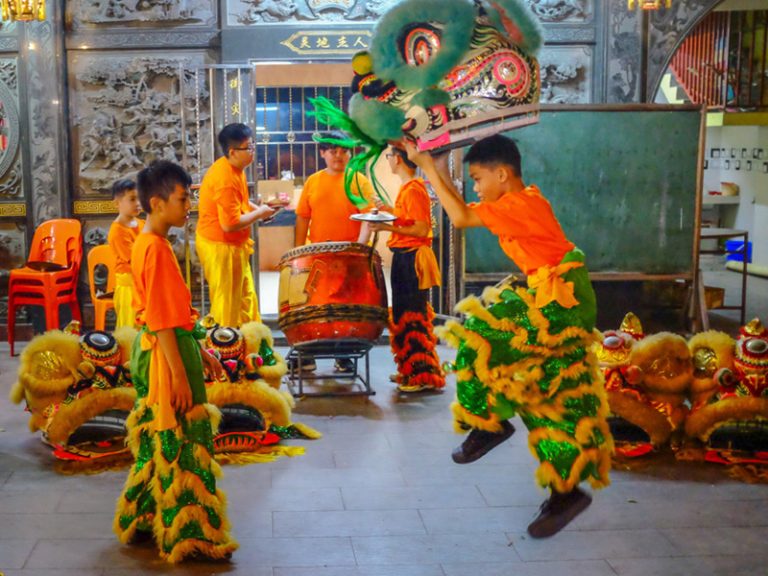
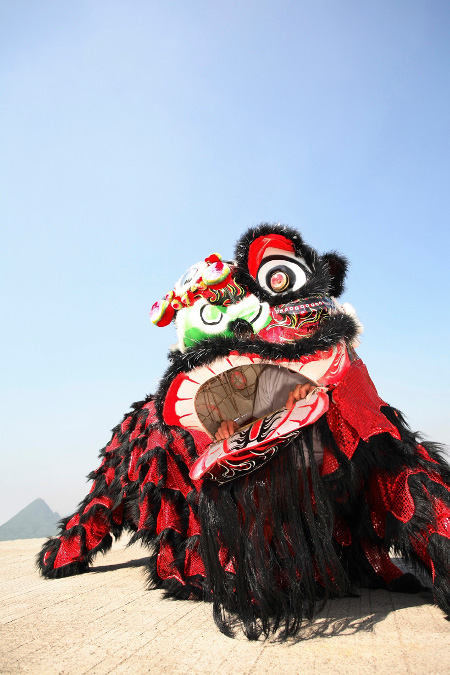
When performed well, lion dancing can lead audiences to perceive the lion as one entity instead of two dancers beneath a costume. Image: INMAGINE
Eight-foot poles make for an eye-catching backdrop to the Hao Ling Gong temple in Setapak, Malaysia. In the foreground, lion heads and water bottles lie scattered across the field, as children stretch and engage in warm-up exercises, while a few others adjust their frilled pants. This is the training site where Lawrence Ng, assistant chief coach of Meng Kok Dragon & Lion Dance Association, holds his weekly lion dance practice sessions. He picked up the traditional art as a hobby at a young age, and has been actively involved ever since.
I gape in awe at the poles, wondering how performers navigate the narrow platforms, where the slightest misstep could easily lead to grave injuries. Ng catches my gaze and says, “Those are for acrobatic lion dancing. We won’t be using them tonight. We’re focusing on traditional lion dancing to prepare for the Chinese New Year season.”
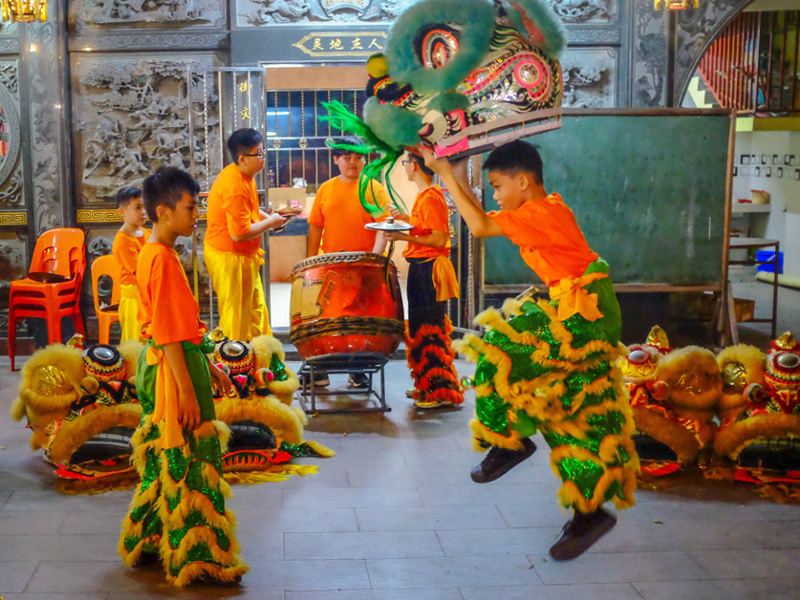
Sometimes, Ng’s students practise within the Hao Ling Gong temple itself. Photography: Daniel Chan.
Each of his three groups of students is guided by senior lion dancers, and I notice that most of the children are ushered into the first group. As they proceed to pick up the lion heads and work on the most basic of movements – the bowing, snapping and fluttering that precedes every performance – Ng explains, “If they cannot do this part correctly, they cannot move on.” In this instance, ‘moving on’ means learning about the finer aspects of this demanding routine, the subtle nuances that casual observers often take for granted. I watch as a senior shows his protégé the mentality behind every step. “Imagine a lion pouncing on its prey,” the senior says. “It doesn’t just step on it. It grips and mauls its victim. That’s how you have to approach the food. Once you jump on it, you never let go.”
All this teaching and practice takes place amidst the almost deafening sound of drums, beaten by a student wielding sticks thicker than his forearms! It is apparent that the future of this art form rests on the shoulders of these young people, and I begin to question if this astounding tradition even stands a chance in the face of modernity. As if on cue, a child walks into the temple, tugs Ng on the arm and asks, “Sifu, how do I sign up?”
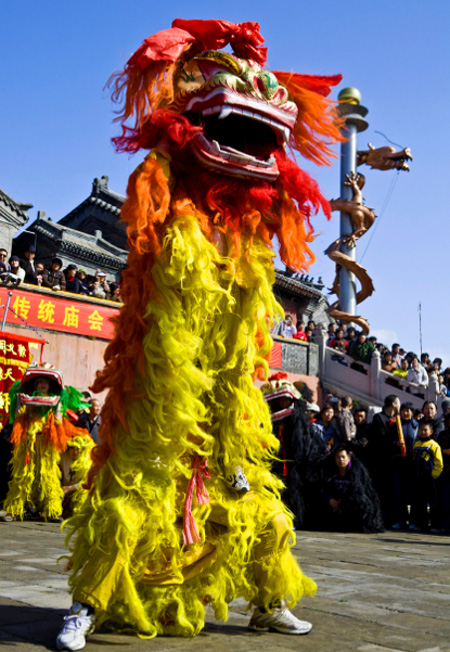
Besides diff erent dance routines, the Northern lion is easily distinguishable from its Southern counterpart by its longer fur and squarish face. Image: INMAGINE
MANE ACT
Lion dancing is a broad term, and has many subcategories. At the most basic level, there are two styles of dance – Northern and Southern, each with its own distinct characteristics. The Northern style presents a lion that is hairier and heavier in appearance, and was a dance performed for entertainment in the imperial courts of northern China. The Southern style, on the other hand, features a lighter bodied lion, and is the more popular variant today, especially in Southeast Asia. The southern dance style further diverges into two branches called Fut San (Buddha Mountain) and Hok San (Crane Mountain). The former is the older of the two, and is known to be snappier and more explosive, while Hok San is the contemporary variant, and features fluid movements and softer choreography.
The actual origins of the southern lion dance remains shrouded in mystery, as its roots can be traced back to both folk stories and historical events. In Malaysia, the beginning of lion dancing is steeped in folklore, in the legend of the Nian monster. As the story goes, every year, the monstrous creature descended from the mountains to terrorise the villagers below. Upon discovering Nian’s fear of loud noises and of the colour red, the villagers donned red robes and a lion head, and made as much rambunctious noise as they could by banging on pots and pans. It is believed that this scared Nian away forever, and since then, the tradition has become a yearly festival of bright colours, dance, fireworks and drums.
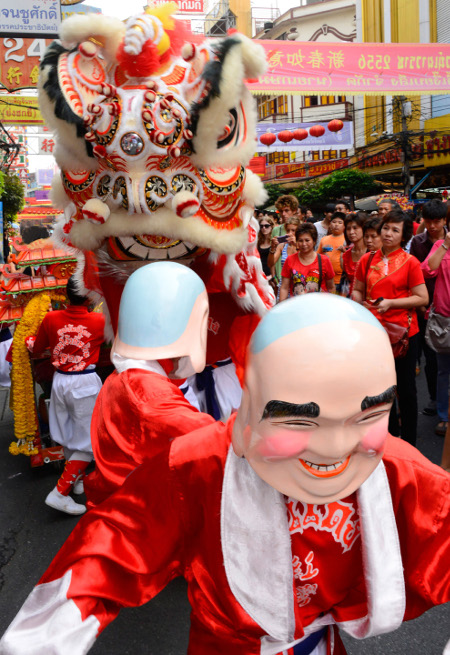
In some performances, the Big Head Buddha is present as well, and he often teases the lion with his fan. It’s believed that the lion is a mischievous creature, and the Big Head Buddha helps tame it. Image: INMAGINE
While the factual origin of the southern lion dance seems fragmented, there are some interesting historical narratives that surround the art. One such account is where, during the Qing dynasty (1644-1912), lion dance performances were often used by Ming rebels to circulate secret messages among their group. This was usually done via the choi qing (get the green) routine of the dance, when the lion ‘consumed’ a head of lettuce and then, spat it out. The secret messages were cleverly hidden among the lettuce leaves, and during the choi qing, the lion dancers extracted the notes, which were then passed on to the rebels. The action itself also carried within it sentiments of propaganda, as the Chinese word for ‘green’ sounds similar to Qing. And so, the sequence in which the lion spits out the lettuce represented an act of defi ance against the dynasty. In modern times, the meaning of this sequence is entirely different. Choi qing is now used to symbolise good fortune, and interestingly enough, the phrase shares a phonetic similarity to the word ‘prosperity’ in Chinese as well.
GETTING A-HEAD
But, it’s not all about the dancers. One of the most dramatic elements of the lion dance is, of course, the costume that features an expressive lion head capable of furiously batting its eyelids and opening and closing its mouth. This is made possible through the craftsmanship of the lion head makers. To learn first-hand about the creation of these masterpieces, I visit the workshop of Chong Yen Heng, one of the five major lion head producers in Malaysia.
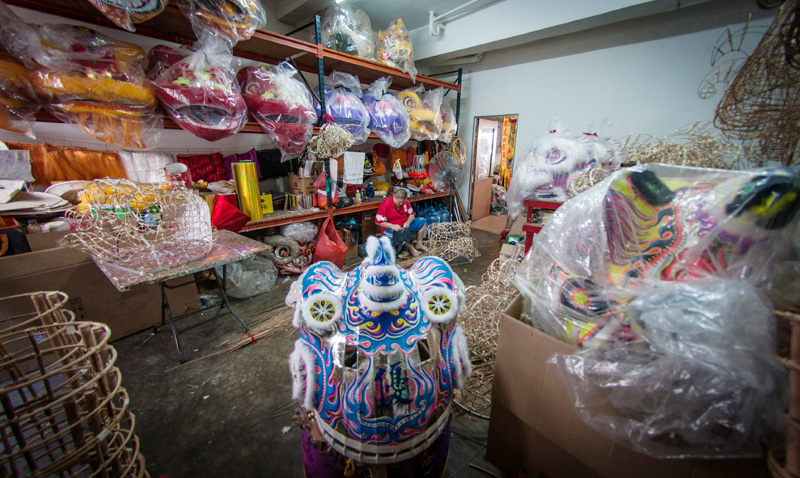
Chong’s workshop is full of lion heads in various stages of production. Photography: Daniel Chan.
In Chong’s workshop in Kuala Lumpur, the first thing he does is dispel the myth that production is seasonal. “During my master’s era, Chinese New Year was crunch time for lion head production. Today, the increased popularity of lion dancing means that there are no specific seasons anymore,” he says. “Lion dances are now performed at opening ceremonies, corporate events, housewarmings, and even to welcome or send off guests. Not only that, it is also becoming popular among the non-Chinese, so the demand for our work is quite consistent year-round.”
Lion heads are handmade, with the knowledge and craftsmanship handed down through the generations. Chong picked up the trade when he was 12 years old, and now at 43, he is passing on his know-how and expertise to his apprentices. As this craft requires precision, it can only be mastered through consistent practice.
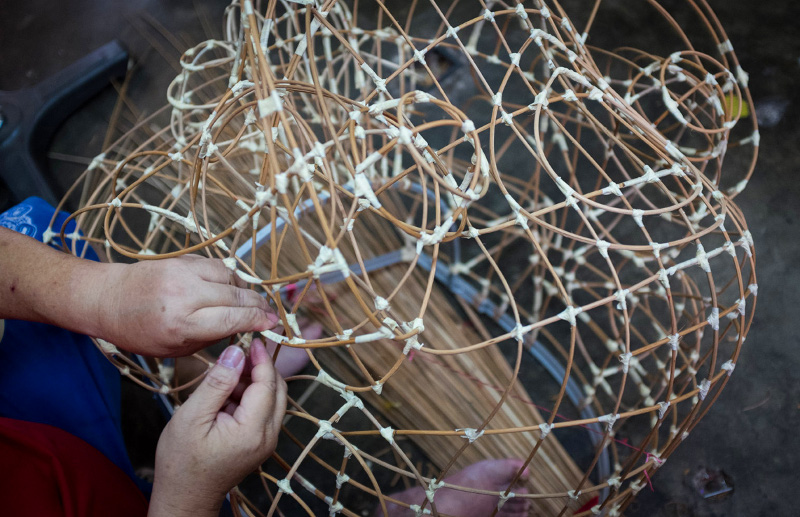
Malaysia’s warm and humid weather allows craftsmen to bind the frames with masking tape. In drier or colder countries, tape does not produce the same grip, so paper strips or wires are used instead. Photography: Daniel Chan.
Lion head production is divided into the four main tasks: framing, papering, painting and adorning, which have to be executed in that order. The steps have always been the same, and the craftsmen are encouraged to learn every aspect of the production process, although ultimately, they can specialise in one chosen task.
The first task, referred to as framing, involves fashioning the shape of the lion’s head. The frame is traditionally made with bamboo. However, in Malaysia, rattan is more commonly used due to its abundance. Rattan actually has a few advantages over bamboo; it is not only more pliable, making it easier to work with, but also less likely to break and injure the dancers. While now adept in the skill of framing, Chong admits that as a novice, he had to force himself to learn this task, as it was his least favourite part of the process.
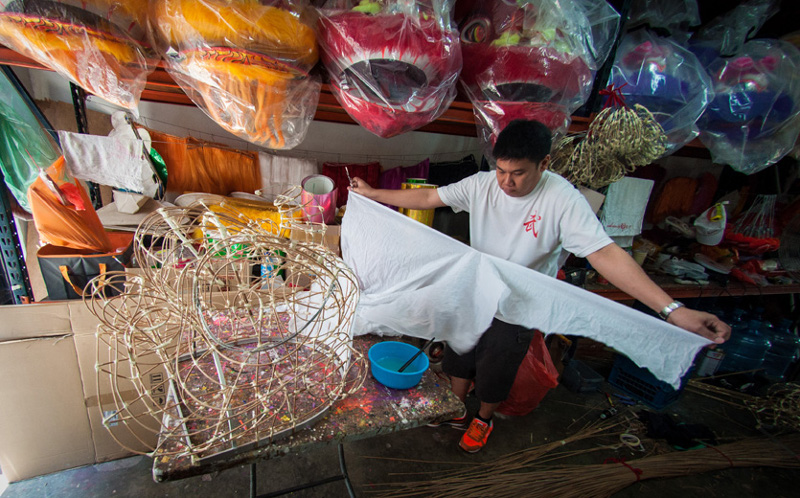
A craftsman at Chong’s workshop begins the papering process on the back of the lion’s head, small patches at a time. Photography: Daniel Chan.
When framing is complete, the head moves on to the next stop in the production line – papering. Here, the head makers glue a special type of transparent paper all over the frame, patching it on in small pieces, layer upon layer until the papering is approximately six layers thick. Trying to cut corners by gluing large sheets of paper onto the frame will result in uneven layers, with a higher risk of the paper tearing. As the lion dance involves rigorous movements, the lion head must be able to withstand the demands of the dance. A badly papered head might not even make it through its first performance!
Once the papered mould is dry and ready, the painters take over, sticking shiny or coloured paper as the base for their intricate patterns. They then proceed to hand-paint the general themes of flames, spirals and dots, which are auspicious symbols for the Chinese. These days, many lion head makers push the envelope, experimenting on embellishments for lion heads, and in Malaysia, you can even find lions sporting batik designs!
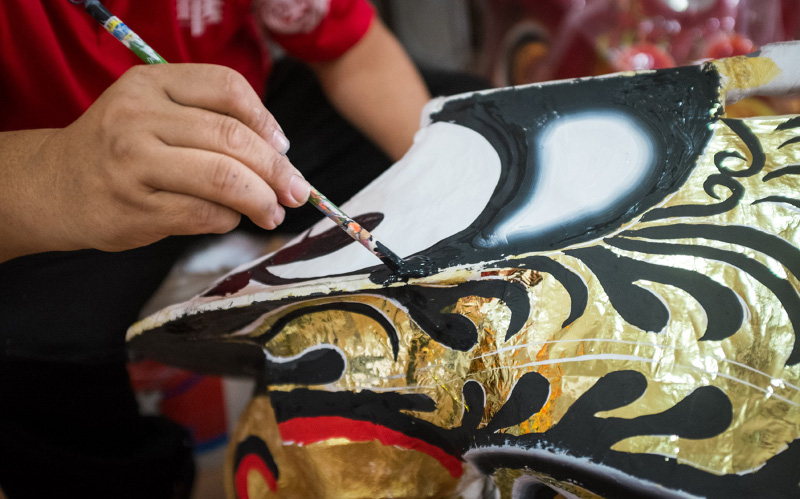
Painting is done freehand, and after the designs are completed, another layer of lacquer is added to increase durability and water resistance. Photography: Daniel Chan.
The final stage is where the lion head comes alive, as its eyelids, mouth and forehead are adorned with faux fur. Mirrors, which are believed to repel negative energy, are also added at this point, and the finishing touches like the eyeballs are also tacked on. I’m impressed that Chong keeps up with the times by fixing LED lights onto some of the lions’ heads, backs and legs, resulting in a beautiful spectacle for night shows.
The entire process, from framing to adorning the lion head, takes approximately seven days to complete, under optimal conditions. Wet weather, for instance, can delay the process, as it takes longer for the glue and paint to dry, and custom requests or special designs also add on to the production time. Upon completion, the brand new lion heads – each weighing approximately 8kg – are carefully packed and sent off to Chong’s customers.
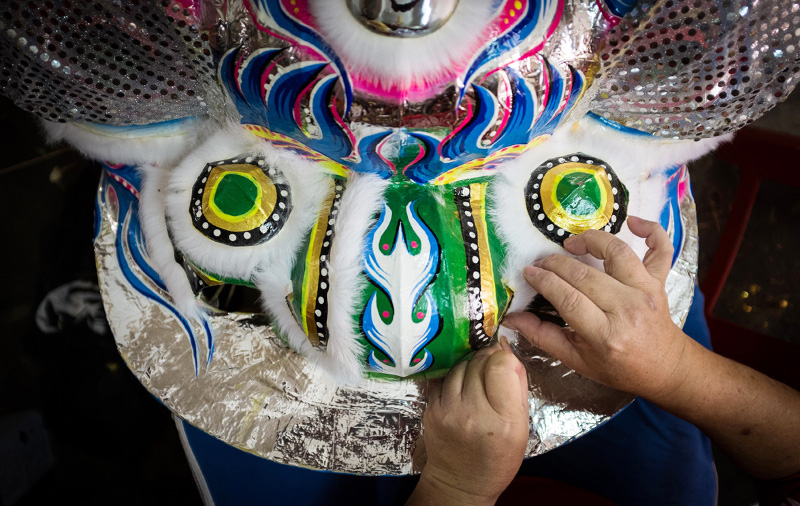
Synthetic-fur trimmings are added as a finishing touch. Balls, ribbons, and LED lights are added at this point to complete the designs. Photography: Daniel Chan.
THE LION’S TALE
Unbeknownst to many, each performance follows a set storyline. Different lion dance schools may come up with choreographies of their own, but the basic elements remain the same. Before the story unfolds, the lion must first perform opening bows to acknowledge the audience. It then portrays its hunger, and is prompted on its quest for food. Upon finding it, the lion proceeds to retrieve its fare before bringing the performance to a close. Every dance finishes with a happy ending.
Each lion is brought to life by a team of two; one person plays the head, and the other, the tail. Compared to acrobatic lion dancing, the traditional variant is fairly straightforward. As the tail is mainly only required to complement the head and follow its steps, not much emphasis is given to the tail during training. Ng’s dancers, therefore, often switch roles, so everyone has a chance to perform in both positions.
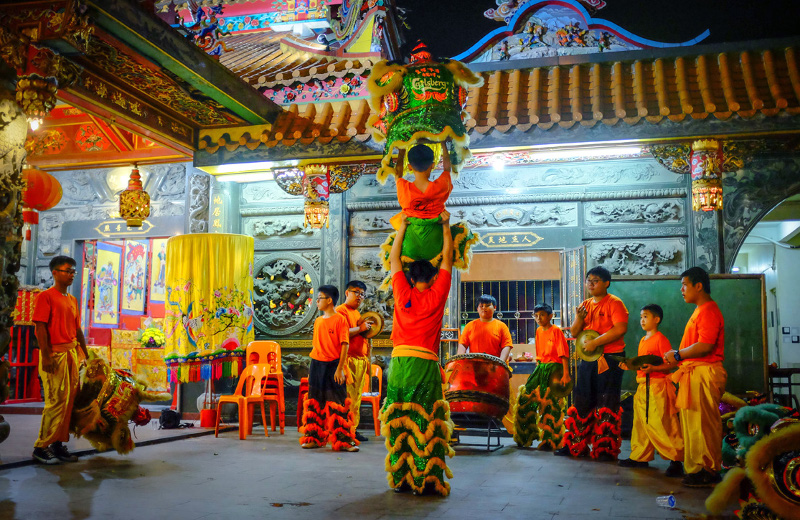
Lion dance is a physically demanding art, and is commonly associated with kung-fu because of the athleticism it requires. Photography: Daniel Chan.
One of the amazing things I learn while talking to Ng is that while there aren’t any formal cues in the lion dance, experienced dancers are able to read each other as they move, much like partners in other artistic performances like the swing or salsa. “We call it the lion’s language,” Ng says. “I can’t speak French, Vietnamese or Indonesian, but when it comes to dancing with people of those nations, we understand each other perfectly.” That’s when I realise that music and dance truly are universal.
This ‘understanding’ is taken up a notch in acrobatic lion dancing, where partners stay together for their entire careers. “When you perform such risky moves on the poles, you have to know that your partner is always there to back you up. You need someone that understands your every tic, because there’s very little room for miscommunication. Even your weight and body shape matter, which is why acrobatic dancers don’t generally change partners,” Ng says. “Dancers whose partners are side-lined by injury hardly have any chance in finding a new compatible partner. What’s more, the fact that most dancers retire relatively young, usually in
their early 30s, only makes it more difficult to find a suitable replacement,” elaborates Ng.
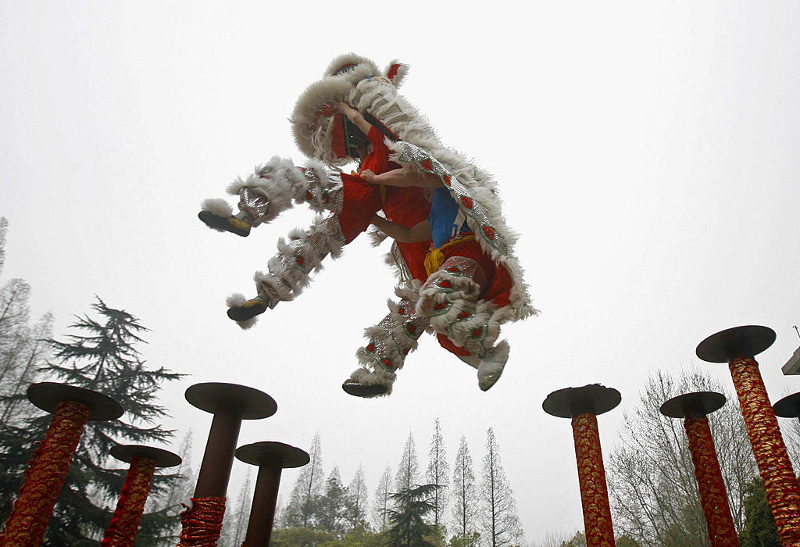
Acrobatic lion dancing involves high-flying stunts off poles that can be as tall as three metres. Image: Getty
On the bright side, there are other positions within the troupe that also play an integral role in lion dancing – the percussionists. While the dancers are generally the highlight of the show, the drummer is an irreplaceable asset who completes the picture. The drummer’s beats dictate the lion’s pace, with a different rhythm accompanying each of its actions. An ensemble usually comprises of one drummer, one gong player and two cymbal players. While cymbal players can vary according to the size of the performance, there is generally only one drummer and one gong player.
THE ART LIVES ON
When it comes to lion dancing, there’s more to the art than just putting on a show for the masses. It is also a viable outlet for young children and adults to channel their energy in a disciplined, productive manner. As Ng poignantly puts it, “I do this not just to preserve the ancient art; it’s also a great way to keep children away from vices. I’m proud to say that this sport cultivated discipline in me. And I’d like to think that the art also helps make the world a better place.”
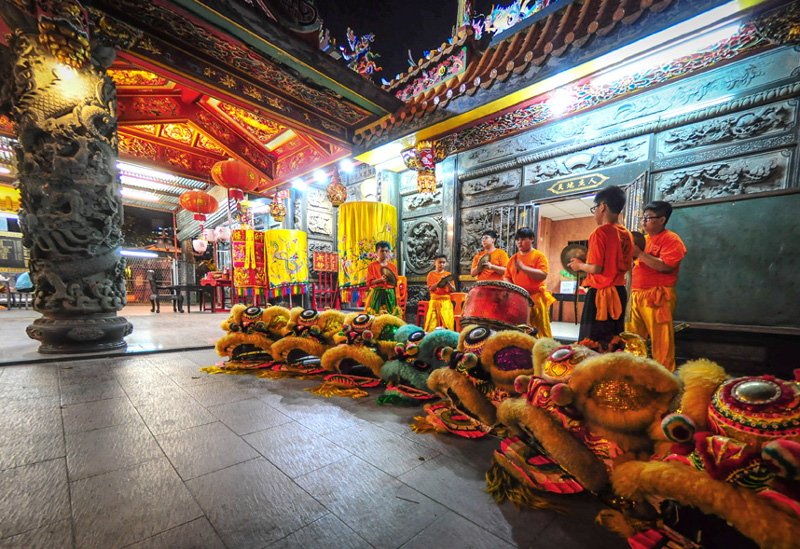
The sparse surroundings of Hao Ling Gong temple affords drummers the opportunity to practise on real equipment. In densely-populated areas, drummers make do with padded cymbals or practice pads. Photography: Daniel Chan.
It is abundantly clear as I spend time with both Ng and Chong that both men have a deep passion for lion dancing. Now old-timers in the industry, they have paid their dues as apprentices, and presently busy themselves sharing knowledge of their craft with the younger generation, so, one day, they may carry on this legacy. And as Ng’s latest recruit dons a pair of golden-frilled pants and starts learning the basics, an earnest look on his young face, I get a feeling that the future of lion dancing will still be shiny and bright. This art form will endure, finding its way into the next century, roaring, leaping and dancing.
DID YOU KNOW?
Malaysia is one of the world’s leading nations for lion dancing. There are approximately 1,000 traditional dance troupes in the country, with around 30 teams specialising in the acrobatic category.
LION DANCE RULES
When it comes to competition, routines are relatively short compared to normal performances, with a maximum time allotment of 10 minutes. The dances are judged based on these criteria.
EXPRESSION The lion must clearly convey various emotions, such as happiness, anger and sadness.
STORYLINE The overall performance and the troupe’s execution of their choice dance style must adhere to the general storyline.
ACROBATICS Jumps and athletic feats are rewarded according to the complexity and diffi culty in execution.
MUSICAL ACCOMPANIMENT The drums, gongs and cymbals must beat in unison, and the lion has to be in sync with the music.
COSTUME The team’s appearance, especially their uniforms, are graded based on tidiness and workmanship.








